Navigation
First Deep-Sea Observatory Being Established with Thirty-two Mile Cable Installed Off of Monterey Bay
Oceanographers have completed an important step in constructing the first deep-sea observatory off the continental United States.
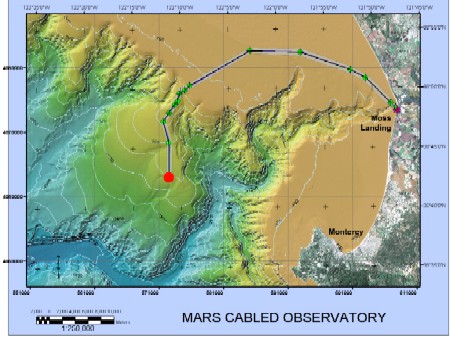 |
| This map shows the proposed location of the MARS science node (red dot) on the seafloor of Monterey Bay. It also shows the proposed route for the undersea cable that will provide a data and power connection between the science node and MBARI's shore facilities at Moss Landing.: Image credit: (c) 2004 MBARI |
Oceanographers have completed an important step in constructing the first deep-sea observatory off the continental United States. Workers in the multi-institution effort laid 32 miles (52 kilometers) of cable along the Monterey Bay sea floor that will provide electrical power to scientific instruments, video cameras, and robots 3,000 feet (900 meters) below the ocean surface. The link will also carry data from the instruments back to shore, for use by scientists and engineers from around the world.
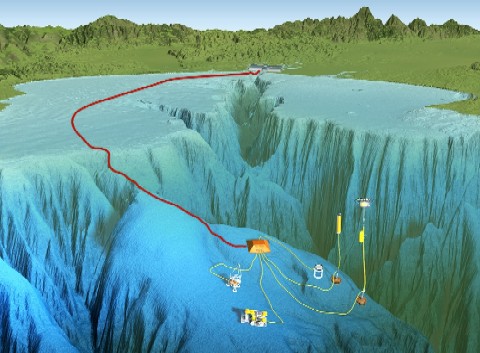 |
| The Monterey Accelerated Research System (MARS) will allow scientists to perform long-term and real-time experiments 900 meters below the surface of Monterey Bay. The main MARS science node (orange box with sloping sides) will connect to shore through a 52-km-long power and fiber-optic cable. MARS will serve as an engineering, science, and education test bed for even more extensive ocean observatories in the US and Canada. Image: David Fierstein (c) 2005 MBARI |
Workers in the multi-institution effort laid 32 miles (52 kilometers) of cable along the Monterey Bay sea floor that will provide electrical power to scientific instruments, video cameras, and robots 3,000 feet (900 meters) below the ocean surface.
The link will also carry data from the instruments back to shore, for use by scientists and engineers from around the world.
The Monterey Accelerated Research System (MARS) observatory, due to be completed later this year, will provide ocean scientists with 24-hour-a-day access to instruments and experiments in the deep sea.
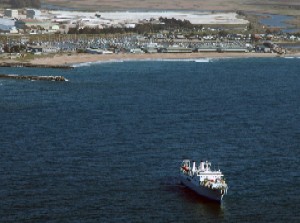 |
| In mid-March, 2007, the cable-laying ship Global Sentinel began laying the MARS observatory cable just offshore of MBARI's facilities in Moss Landing California. Image credit: Todd Walsh (c) 2007 MBARI |
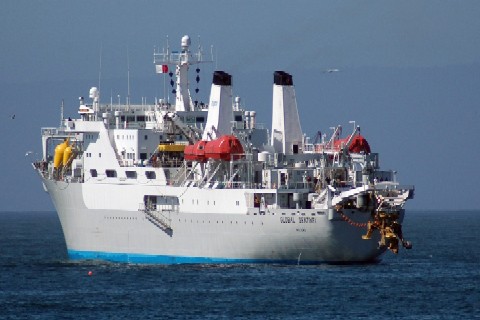 |
| The cable-laying ship Global Sentinel began laying the MARS observatory cable just offshore of Moss Landing California in mid March, 2007. The yellow object hanging from the stern of the vessel is the underwater plow that is used to bury the cable beneath a meter (three feet) below the seafloor.Image credit: Todd Walsh (c) 2007 MBARI |
The project is managed by the Monterey Bay Aquarium Research Institute (MBARI) and funded by the National Science Foundation (NSF).
Currently, almost all oceanographic instruments in the deep sea rely on batteries for power and store their data on hard disks or memory chips until they are brought back to the surface. With a continuous and uninterrupted power supply, instruments attached to the MARS observatory could remain on the sea floor for months or years.
"MARS represents the first step in a long-planned process to transform the way the oceans are studied," said Julie Morris, director of NSF's Division of Ocean Sciences. "Marine scientists will no longer be required to go out to the ocean for their studies. The ocean is about to come into their offices."
If something goes wrong with the instruments, scientists will know immediately, and will be able to recover or reprogram them as necessary.
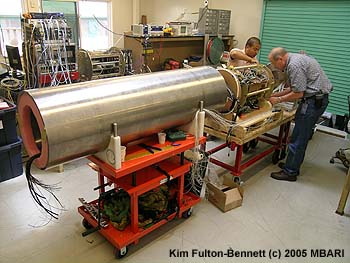 |
| In early August 2005, MBARI electronics technicians Dick Littlefield and Jose Rosal prepared the wiring for the MARS data hub and power-supply. The completed package will sit inside the long stainless steel cylinder, which is designed to protect the delicate electronics from the crushing pressure of the deep sea.Image credit: Kim Fulton-Bennett (c) 2005 MBARI |
Slightly thicker than a garden hose, the MARS cable is buried about 3 feet below the sea floor along most of its route, so it will not be disturbed by boat anchors or fishing gear.
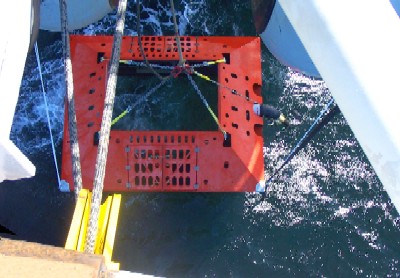 |
| This view from the bow of the cable-laying ship shows the trawl-resistant frame being lowered into Monterey Bay. Image credit: Knute Brekke (c) 2007 MBARI |
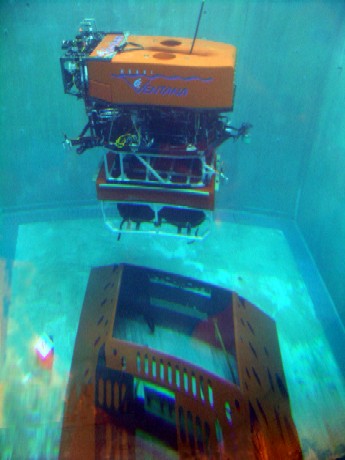 |
| In June 2005, the trawl-resistent frame was lowered carefully into the MBARI test tank so that the pilots of MBARI remotely operated vehicle (ROV) Ventana could practice installing a "dummy" electronics module. Image credit: (c) 2005 Nautronics MariPro |
The cable itself contains a copper electrical conductor and strands of optical fiber. The copper conductor will transmit up to 10 kilowatts of power from a shore station at Moss Landing, Calif., to instruments on the sea floor. The optical fiber will carry up to 2 gigabits per second of data from these instruments back to researchers on shore, allowing scientists to monitor and control instruments 24 hours a day, and to have an unprecedented view of how environmental conditions in the deep sea change over time.
"After 5 years of hard work, we are thrilled to bring the age of the Internet to the deep ocean, so we can understand, appreciate and protect the two-thirds of our planet that lies under the sea," said MBARI director Marcia McNutt. "We are grateful for the help of our talented partners and visionary sponsors. MARS has truly been a team effort."
At the seaward end of the MARS cable is a large steel frame about 4 feet (1.2 meters) tall and 15 feet (4.6 meters) on each side. This "trawl-resistant frame" will protect the electronic "guts" of the MARS observatory, which will serve as a computer network hub and electrical substation in the deep sea. The researchers hope to install these electronic components into the trawl-resistant frame in the fall of 2007.
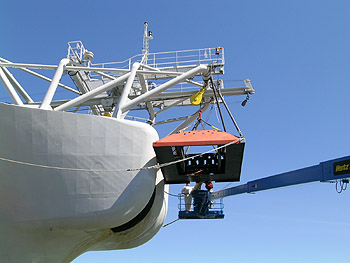 |
| After laying the MARS observatory cable, the cable-laying ship Global Sentinel went to San Francisco Harbor pick up the trawl-resistant frame (orange object at bow of ship) that will protect the electronic "guts" of the observatory from damage by anchors or fishing gear. The electronic "guts" of the observatory will be installed in the open area in the center of the frame. Image credit: Knute Brekke (c) 2007 MBARI |
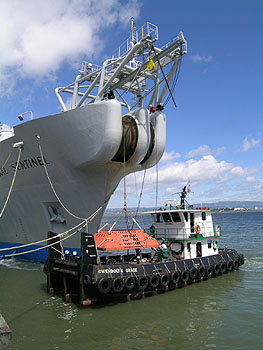 |
| After laying the MARS observatory cable, the cable-laying ship Global Sentinel went to San Francisco Harbor pick up the trawl-resistant frame (orange object at bow of ship) that will protect the electronic "guts" of the observatory from damage by anchors or fishing gear.Image credit: Knute Brekke (c) 2007 MBARI |
After the electronics package is installed and tested, scientists from around the world will be able to attach their instruments to the observatory using underwater extension cords. These instruments will be carried down from the surface and plugged into the science node using MBARI's remotely operated vehicles.
MARS also will serve as a testing ground for technology that will be used on more ambitious deep-sea observatories. As planned, such observatories will use thousands of kilometers of undersea cables to hook up dozens of seismographs and oceanographic monitoring stations. They will provide scientists with new views of sea floor life, and a new understanding of the global tectonic processes that spawn earthquakes and tsunamis.
"MARS is the harbinger of an international ocean observatory network that will enable scientists to study ocean features and changing conditions," said Morris. "New ocean observing capabilities will provide knowledge about the ocean, and information to better manage and preserve ocean resources."
The MARS project was initiated in 2002 with $8 million in grants from the National Science Foundation (NSF) and $1.75 million from the David and Lucille Packard Foundation. NSF also contributed an additional $2 million to meet permitting and homeland security requirements. Components for the observatory are being designed and built by MBARI, the University of Washington, Woods Hole Oceanographic Institution, Nautronics Maripro, and Alcatel.
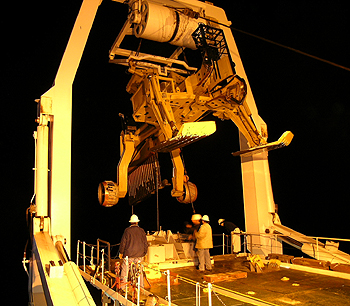 |
| This photo shows the undersea plow that was used to bury the MARS cable one meter (three feet) below the seafloor. The cable-laying ship Global Sentinel worked 24-hours-a-day to lay the cable. Image credit: Knute Brekke (c) 2007 MBARI |
Contacts:
Kim Fulton-Bennett, MBARI (831) 775-1835 kfb@mbari.org
Related Websites
MARS Observatory: http://www.mbari.org/mars/
Search
Latest articles
Agriculture
- World Water Week: Healthy ecosystems essential to human health: from coronavirus to malnutrition Online session Wednesday 24 August 17:00-18:20
- World Water Week: Healthy ecosystems essential to human health: from coronavirus to malnutrition Online session Wednesday 24 August 17:00-18:20
Air Pollution
- "Water and Sanitation-Related Diseases and the Changing Environment: Challenges, Interventions, and Preventive Measures" Volume 2 Is Now Available
- Global Innovation Exchange Co-Created by Horizon International, USAID, Bill and Melinda Gates Foundation and Others
Biodiversity
- It is time for international mobilization against climate change
- World Water Week: Healthy ecosystems essential to human health: from coronavirus to malnutrition Online session Wednesday 24 August 17:00-18:20
Desertification
- World Water Week: Healthy ecosystems essential to human health: from coronavirus to malnutrition Online session Wednesday 24 August 17:00-18:20
- UN Food Systems Summit Receives Over 1,200 Ideas to Help Meet Sustainable Development Goals
Endangered Species
- Mangrove Action Project Collaborates to Restore and Preserve Mangrove Ecosystems
- Coral Research in Palau offers a “Glimmer of Hope”
Energy
- Global Innovation Exchange Co-Created by Horizon International, USAID, Bill and Melinda Gates Foundation and Others
- Wildlife Preservation in Southeast Nova Scotia
Exhibits
- Global Innovation Exchange Co-Created by Horizon International, USAID, Bill and Melinda Gates Foundation and Others
- Coral Reefs
Forests
- NASA Satellites Reveal Major Shifts in Global Freshwater Updated June 2020
- Global Innovation Exchange Co-Created by Horizon International, USAID, Bill and Melinda Gates Foundation and Others
Global Climate Change
- It is time for international mobilization against climate change
- It is time for international mobilization against climate change
Global Health
- World Water Week: Healthy ecosystems essential to human health: from coronavirus to malnutrition Online session Wednesday 24 August 17:00-18:20
- More than 400 schoolgirls, family and teachers rescued from Afghanistan by small coalition
Industry
- "Water and Sanitation-Related Diseases and the Changing Environment: Challenges, Interventions, and Preventive Measures" Volume 2 Is Now Available
- Global Innovation Exchange Co-Created by Horizon International, USAID, Bill and Melinda Gates Foundation and Others
Natural Disaster Relief
- STOP ATTACKS ON HEALTH CARE IN UKRAINE
- Global Innovation Exchange Co-Created by Horizon International, USAID, Bill and Melinda Gates Foundation and Others
News and Special Reports
- World Water Week: Healthy ecosystems essential to human health: from coronavirus to malnutrition Online session Wednesday 24 August 17:00-18:20
- STOP ATTACKS ON HEALTH CARE IN UKRAINE
Oceans, Coral Reefs
- World Water Week: Healthy ecosystems essential to human health: from coronavirus to malnutrition Online session Wednesday 24 August 17:00-18:20
- Mangrove Action Project Collaborates to Restore and Preserve Mangrove Ecosystems
Pollution
- Zakaria Ouedraogo of Burkina Faso Produces Film “Nzoue Fiyen: Water Not Drinkable”
- "Water and Sanitation-Related Diseases and the Changing Environment: Challenges, Interventions, and Preventive Measures" Volume 2 Is Now Available
Population
- "Water and Sanitation-Related Diseases and the Changing Environment: Challenges, Interventions, and Preventive Measures" Volume 2 Is Now Available
- "Water and Sanitation-Related Diseases and the Changing Environment: Challenges, Interventions, and Preventive Measures" Volume 2 Is Now Available
Public Health
- Honouring the visionary behind India’s sanitation revolution
- Honouring the visionary behind India’s sanitation revolution
Rivers
- World Water Week: Healthy ecosystems essential to human health: from coronavirus to malnutrition Online session Wednesday 24 August 17:00-18:20
- Mangrove Action Project Collaborates to Restore and Preserve Mangrove Ecosystems
Sanitation
- Honouring the visionary behind India’s sanitation revolution
- Honouring the visionary behind India’s sanitation revolution
Toxic Chemicals
- "Water and Sanitation-Related Diseases and the Changing Environment: Challenges, Interventions, and Preventive Measures" Volume 2 Is Now Available
- Actions to Prevent Polluted Drinking Water in the United States
Transportation
- "Water and Sanitation-Related Diseases and the Changing Environment: Challenges, Interventions, and Preventive Measures" Volume 2 Is Now Available
- Urbanization Provides Opportunities for Transition to a Green Economy, Says New Report
Waste Management
- Honouring the visionary behind India’s sanitation revolution
- Honouring the visionary behind India’s sanitation revolution
Water
- Honouring the visionary behind India’s sanitation revolution
- Honouring the visionary behind India’s sanitation revolution
Water and Sanitation
- Honouring the visionary behind India’s sanitation revolution
- Honouring the visionary behind India’s sanitation revolution

